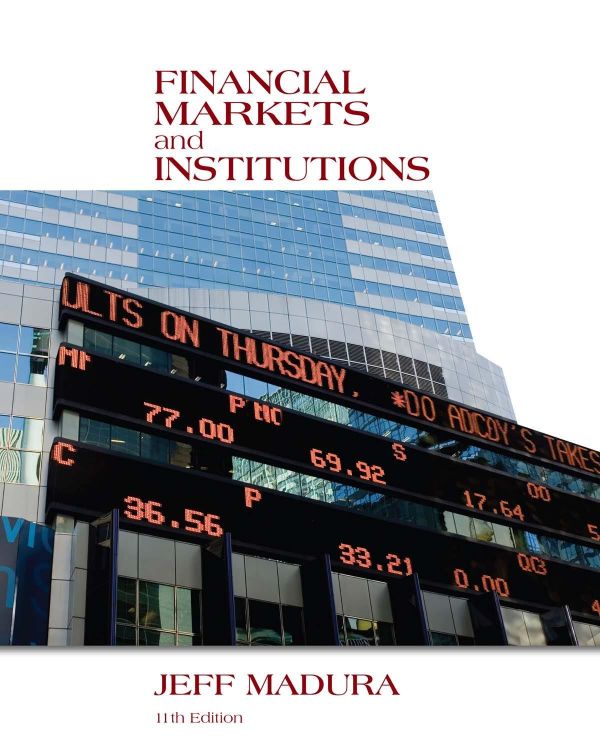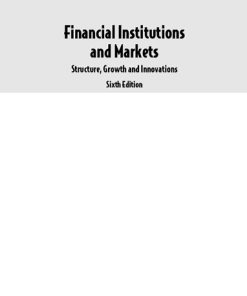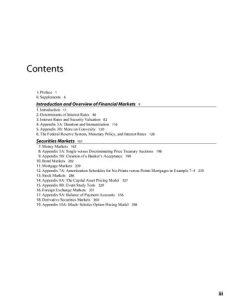Financial Markets and Institutions 11th Edition by Jeff Madura 1305143005 9781305143005
$50.00 Original price was: $50.00.$25.00Current price is: $25.00.
Financial Markets and Institutions 11th Edition by Jeff Madura – Ebook PDF Instant Download/DeliveryISBN: 1305143005, 9781305143005
Full download Financial Markets and Institutions 11th Edition after payment.

Product details:
ISBN-10 : 1305143005
ISBN-13 : 9781305143005
Author: Jeff Madura
Important Notice: Media content referenced within the product description or the product text may not be available in the ebook version.
Financial Markets and Institutions 11th table of contents:
Part 1: Overview of the Financial Environment
Ch 1: Role of Financial Markets and Institutions
Chapter Objectives
1-1: Role of Financial Markets
1-2: Securities Traded in Financial Markets
1-3: Role of Financial Institutions
1-4: Credit Crisis for Financial Institutions
Summary
Term Paper on the Credit Crisis
Ch 2: Determination of Interest Rates
Chapter Objectives
2-1: Loanable Funds Theory
2-2: Factors That Affect Interest Rates
2-3: Forecasting Interest Rates
Summary
Ch 3: Structure of Interest Rates
Chapter Objectives
3-1: Why Debt Security Yields Vary
3-2: Explaining Actual Yield Differentials
3-3: Estimating the Appropriate Yield
3-4: A Closer Look at the Term Structure
3-5: Integrating the Theories of Term Structure
Summary
Part 2: The Fed and Monetary Policy
Ch 4: Functions of the Fed
Chapter Objectives
4-1: Overview
4-2: Organizational Structure of the Fed
4-3: How the Fed Controls Money Supply
4-4: The Fed’s Intervention during the Credit Crisis
4-5: Global Monetary Policy
Summary
Ch 5: Monetary Policy
Chapter Objectives
5-1: Mechanics of Monetary Policy
5-2: Implementing Monetary Policy
5-3: Trade-off in Monetary Policy
5-4: Monitoring the Impact of Monetary Policy
5-5: Global Monetary Policy
Summary
Part 2 Integrative Problem: Fed Watching
Part 3: Debt Security Markets
Ch 6: Money Markets
Chapter Objectives
6-1: Money Market Securities
6-2: Institutional Use of Money Markets
6-3: Valuation of Money Market Securities
6-4: Globalization of Money Markets
Summary
Ch 7: Bond Markets
Chapter Objectives
7-1: Background on Bonds
7-2: Treasury and Federal Agency Bonds
7-3: Municipal Bonds
7-4: Corporate Bonds
7-5: Globalization of Bond Markets
7-6: Other Types of Long-Term Debt Securities
Summary
Ch 8: Bond Valuation and Risk
Chapter Objectives
8-1: Bond Valuation Process
8-2: Explaining Bond Price Movements
8-3: Sensitivity of Bond Prices to Interest Rate Movements
8-4: Bond Investment Strategies
8-5: Valuation and Risk of International Bonds
Summary
Appendix 8: Forecasting Bond Prices and Yields
Ch 9: Mortgage Markets
Chapter Objectives
9-1: Background on Mortgages
9-2: Types of Residential Mortgages
9-3: Valuation and Risk of Mortgages
9-4: Mortgage-Backed Securities
9-5: Mortgage Credit Crisis
Summary
Part 3 Integrative Problem: Asset Allocation
Part 4: Equity Markets
Ch 10: Stock Offerings and Investor Monitoring
Chapter Objectives
10-1: Private Equity
10-2: Public Equity
10-3: Initial Public Offerings
10-4: Stock Offerings and Repurchases
10-5: Stock Exchanges
10-6: Monitoring Publicly Traded Companies
10-7: Market for Corporate Control
10-8: Globalization of Stock Markets
Summary
Ch 11: Stock Valuation and Risk
Chapter Objectives
11-1: Stock Valuation Methods
11-2: Required Rate of Return on Stocks
11-3: Factors That Affect Stock Prices
11-4: Stock Risk
11-5: Risk-Adjusted Stock Performance
11-6: Stock Market Efficiency
11-7: Foreign Stock Valuation and Performance
Summary
Appendix 11: The Link between Accounting and Stock Valuation
Ch 12: Market Microstructure and Strategies
Chapter Objectives
12-1: Stock Market Transactions
12-2: How Stock Transactions are Executed
12-3: Regulation of Stock Trading
12-4: Trading International Stocks
Summary
Part 4 Integrative Problem: Stock Market Analysis
Part 5: Derivative Security Markets
Ch 13: Financial Futures Markets
Chapter Objectives
13-1: Background on Financial Futures
13-2: Interest Rate Futures Contracts
13-3: Stock Index Futures
13-4: Single Stock Futures
13-5: Risk of Trading Futures Contracts
13-6: Globalization of Futures Markets
Summary
Ch 14: Option Markets
Chapter Objectives
14-1: Background on Options
14-2: Determinants of Stock Option Premiums
14-3: Speculating with Stock Options
14-4: Hedging with Stock Options
14-5: Options on ETFs and Stock Indexes
14-6: Options on Futures Contracts
14-7: Options as Executive Compensation
14-8: Globalization of Options Markets
Summary
Appendix 14: Option Valuation
Ch 15: Swap Markets
Chapter Objectives
15-1: Background
15-2: Types of Interest Rate Swaps
15-3: Risks of Interest Rate Swaps
15-4: Pricing Interest Rate Swaps
15-5: Performance of Interest Rate Swaps
15-6: Interest Rate Caps, Floors, and Collars
15-7: Credit Default Swaps
15-8: Globalization of Swap Markets
Summary
Ch 16: Foreign Exchange Derivative Markets
Chapter Objectives
16-1: Foreign Exchange Markets
16-2: Factors Affecting Exchange Rates
16-3: Forecasting Exchange Rates
16-4: Foreign Exchange Derivatives
16-5: International Arbitrage
Summary
Appendix 16: Currency Option Pricing
Part 5 Integrative Problem: Choosing among Derivative Securities
Midterm Self-Exam
Part 6: Commercial Banking
Ch 17: Commercial Bank Operations
Chapter Objectives
17-1: Background on Commercial Banks
17-2: Bank Sources of Funds
17-3: Off-Balance Sheet Activities
17-4: International Banking
Summary
Ch 18: Bank Regulation
Chapter Objectives
18-1: Background
18-2: Regulatory Structure
18-3: Regulation of Bank Operations
18-4: Regulation of Capital
18-5: How Regulators Monitor Banks
18-6: Government Rescue of Failing Banks
18-7: Financial Reform Act of 2010
18-8: Global Bank Regulations
Summary
Ch 19: Bank Management
Chapter Objectives
19-1: Bank Goals, Strategy, and Governance
19-2: Managing Liquidity
19-3: Managing Interest Rate Risk
19-4: Managing Credit Risk
19-5: Managing Market Risk
19-6: Integrated Bank Management
19-7: Managing Risk of International Operations
Summary
Ch 20: Bank Performance
Chapter Objectives
20-1: Valuation of a Commercial Bank
20-2: Assessing Bank Performance
20-3: Evaluation of a Bank’s ROA
Summary
Part 6 Integrative Problem: Forecasting Bank Performance
Part 7: Nonbank Operations
Ch 21: Thrift Operations
Chapter Objectives
21-1: Background on Savings Institutions
21-2: Sources and Uses of Funds
21-3: Valuation of a Savings Institution
21-4: Exposure to Risk
21-5: Management of Interest Rate Risk
21-6: Exposure of Savings Institutions to Crises
21-7: Credit Unions
Summary
Ch 22: Finance Company Operations
Chapter Objectives
22-1: Types of Finance Companies
22-2: Sources and Uses of Funds
22-3: Valuation of a Finance Company
22-4: Exposure of Finance Companies to Risk
22-5: Multinational Finance Companies
Summary
Ch 23: Mutual Fund Operations
Chapter Objectives
23-1: Background on Mutual Funds
23-2: Performance of Mutual Funds
23-3: Money Market Funds
23-4: Other Types of Funds
Summary
Ch 24: Securities Operations
Chapter Objectives
24-1: Functions of Securities Firms
24-2: Regulation of Securities Firms
24-3: Valuation of a Securities Firm
24-4: Exposure of Securities Firms to Risk
24-5: Impact of the Credit Crisis on Securities Firms
Summary
Ch 25: Insurance and Pension Fund Operations
Chapter Objectives
25-1: Background
25-2: Life Insurance Operations
25-3: Other Types of Insurance Operations
25-4: Exposure of Insurance Companies to Risk
25-5: Valuation of an Insurance Company
25-6: Background on Pension Funds
25-7: Pension Fund Management
25-8: Performance of Pension Funds
Summary
Part 7 Integrative Problem: Assessing the Influence of Economic Conditions across a Financial Conglo
Final Self-Exam
Appendix A: Comprehensive Project
Part I. Applying Financial Markets Concepts
Part II. Applying Financial Institutions Concepts
Part III. Measuring Stock Performance
People also search for Financial Markets and Institutions 11th:
financial markets and institutions pdf
financial markets and institutions 10th edition pdf
financial markets and institutions 10th edition
financial markets and institutions 8th edition
financial markets and institutions saunders pdf
Tags: Financial Markets, Institutions, Jeff Madura, description
You may also like…
Politics & Philosophy - Government & Politics
Business & Economics
International Financial Management 13th Edition Jeff Madura 9798214346168
Business & Economics
Uncategorized
Business & Economics
Business & Economics - Personal Finance
Financial Markets & Institutions (MindTap Course List) 13th Edition Jeff Madura
Business & Economics
Business & Economics












